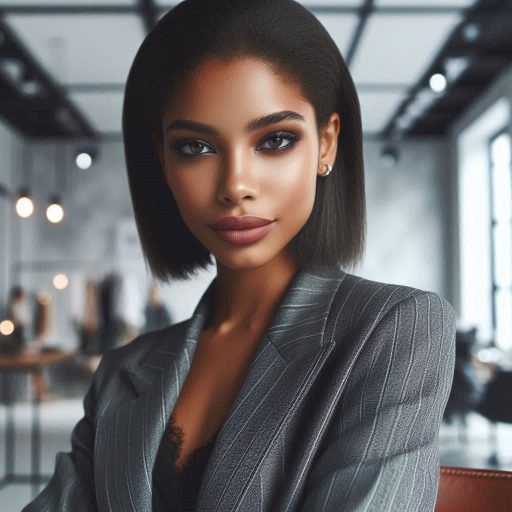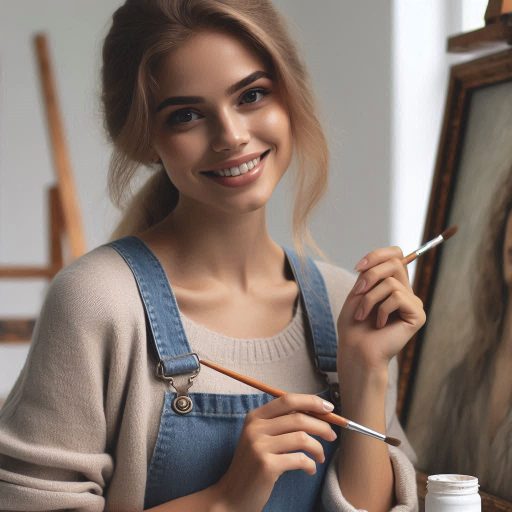Introduction
In this blog post we will be talking about Fashion Stylist and Designer.
Fashion stylists and designers play distinct yet complementary roles in the fashion industry.
Understanding their differences helps clarify their contributions to fashion.
A fashion stylist curates looks for clients, guiding them on how to dress for various occasions.
Stylists work with clothing, accessories, and personal style to enhance a client’s appearance.
They consider factors like body type, lifestyle, and current trends to create cohesive outfits.
Stylists often collaborate with photographers, makeup artists, and models to achieve the desired look for fashion shoots or public appearances.
In contrast, a fashion designer creates original clothing and accessories.
Designers develop concepts, sketch designs, and choose fabrics and materials.
They translate their vision into actual garments, overseeing production from start to finish.
Designers work closely with pattern makers and manufacturers to ensure their designs are executed precisely.
The key differences between fashion stylists and designers are rooted in their focus and responsibilities.
Stylists are primarily concerned with presentation and styling, while designers focus on creation and innovation.
A stylist’s work involves selecting and combining existing items, whereas a designer invents new items and trends.
Stylists aim to enhance personal style and public image, while designers aim to push fashion boundaries and introduce new concepts.
Stylists are usually hired for their expertise in making existing clothes work for different scenarios.
Designers are hired for their ability to produce new, original fashion items.
Both roles are essential, yet they approach fashion from unique perspectives.
Stylists refine and perfect, while designers dream and create.
Understanding these roles highlights the diverse skills required in the fashion industry and the distinct contributions each profession makes to the world of fashion.
Transform Your Career Today
Unlock a personalized career strategy that drives real results. Get tailored advice and a roadmap designed just for you.
Start NowEducation and Training
When it comes to the fashion industry, there are key differences between a fashion stylist and a fashion designer.
These differences are influenced by various factors, including education, training, job responsibilities, and creative expression.
Educational Background
Fashion designers typically pursue a formal education in fashion design.
They often attend specialized design schools or universities to learn the technical skills and creative processes required to design clothing and accessories.
Designers also study fashion history, textiles, and garment construction to develop a strong foundation in design principles.
On the other hand, fashion stylists may not always have a formal education in fashion.
While some stylists may have a background in fashion-related fields such as marketing or merchandising, others enter the industry through hands-on experience or mentorship opportunities.
Stylists rely heavily on their eye for trends, understanding of body shapes, and knowledge of different brands and designers to curate fashionable looks for clients.
Training and Skill Development
Fashion designers often undergo rigorous training to develop their technical skills and design aesthetics.
They learn how to sketch and illustrate their ideas, drape fabric on dress forms, and create patterns for garments.
Designers also experiment with different materials, colors, and techniques to bring their creative visions to life.
Additionally, designers collaborate with manufacturers and production teams to ensure that their designs are executed correctly.
In contrast, fashion stylists focus on developing their styling skills through practical experience and exposure to the fashion industry.
Stylists work with photographers, models, and clients to gain hands-on experience in creating cohesive and visually appealing outfits.
They learn how to mix and match clothing, incorporate accessories, and style outfits for different occasions and events.
Stylists also stay current with fashion trends and attend fashion shows and industry events to keep their styling skills sharp.
Job Responsibilities
Fashion designers are primarily responsible for creating original designs for clothing, accessories, or footwear.
They start by sketching their ideas and then develop samples and prototypes to showcase their designs.
Designers work closely with patternmakers, sewers, and other garment production specialists to ensure that their designs are translated accurately into finished products.
Designers also oversee the manufacturing process and make necessary adjustments to ensure quality and fit.
Transform Your Career Today
Unlock a personalized career strategy that drives real results. Get tailored advice and a roadmap designed just for you.
Start NowFashion stylists, on the other hand, focus on styling outfits for individuals, events, or photo shoots.
Stylists collaborate with photographers, models, and makeup artists to create visually compelling looks that align with the client’s personal style or the theme of the shoot.
Stylists select clothing, accessories, and props, and may also provide guidance on hair and makeup styling to complete the overall look.
Stylists must have a keen eye for detail, a strong sense of aesthetics, and excellent communication skills to succeed in this role.
In short, while fashion designers and fashion stylists both play important roles in the fashion industry, they have distinct educational backgrounds, training experiences, and job responsibilities that set them apart.
Designers focus on creating original designs and overseeing the production process, while stylists specialize in putting together stylish and cohesive outfits for clients.
Both careers require creativity, passion, and a strong understanding of fashion trends to excel in the competitive fashion industry.
Read: How to Start Your Journey as a Fashion Stylist Today
Creative Process
Fashion designers and stylists both play crucial roles in the fashion industry, but their creative processes are distinct.
Understanding these differences highlights their unique contributions.
Designer is Responsible for Conceiving and Creating Fashion Collections
Fashion designers are the visionaries behind new collections.
They start by researching trends, fabrications, and color palettes.
Designers sketch their ideas and develop prototypes.
Their role involves a deep dive into creativity, envisioning garments from scratch.
They consider how designs will appeal to consumers and fit into market trends.
Designers must stay innovative, blending artistry with functionality.
Their work requires a profound understanding of materials and construction techniques.
Stylist Works with Existing Pieces to Create Cohesive Looks for Editorials, Red Carpet Events, etc.
In contrast, fashion stylists curate and assemble outfits from existing collections.
They select pieces from designers or stores to create cohesive looks.
Stylists focus on presenting garments in a visually appealing way for various events.
Transform Your Career Today
Unlock a personalized career strategy that drives real results. Get tailored advice and a roadmap designed just for you.
Start NowTheir job includes coordinating clothing with accessories and making sure the look aligns with the occasion’s theme.
Stylists often work with magazines, celebrities, and brands to enhance visual storytelling.
Their creativity lies in combining pieces to craft unique and stylish ensembles.
Designer Collaborates with Production Teams to Bring Their Designs to Life, While Stylist Works One-on-One with Clients
Designers collaborate closely with production teams to turn their sketches into tangible garments.
They oversee the manufacturing process, ensuring their vision is accurately realized.
This collaboration involves fabric sourcing, pattern making, and fitting adjustments.
Designers must communicate effectively with manufacturers to maintain the integrity of their designs.
Stylists, however, work directly with clients to understand their preferences and needs.
They provide personalized advice and tailor looks to individual styles and occasions.
Stylists ensure that the client’s wardrobe reflects their personality and enhances their public appearances.
Their role is more focused on personal image and immediate presentation, contrasting with the designer’s long-term creation process.
Understanding these differences clarifies the unique roles each professional plays in the fashion world.
Both are essential, but their creative processes and focuses vary significantly.
Read: Case Studies in Art Conservation and Restoration

Job Responsibilities: Designer vs. Stylist
Designer Oversees the Entire Design Process, from Sketching to Production
A fashion designer manages the entire design journey, from initial concept to finished product.
They start by sketching designs, focusing on fabric choice and garment construction.
Designers create patterns and oversee fittings to ensure their vision is realized.
They work closely with production teams to translate sketches into wearable clothing.
Their role requires a deep understanding of textile technology, fashion trends, and production techniques.
Designers are responsible for ensuring that the final product meets their design standards and quality expectations.
Transform Your Career Today
Unlock a personalized career strategy that drives real results. Get tailored advice and a roadmap designed just for you.
Start NowStylist Shops for Clothing, Accessories, and Other Items to Create Looks for Clients or Projects
In contrast, a fashion stylist curates and assembles outfits rather than creating them from scratch.
Stylists shop for clothing, accessories, and other items that align with their client’s needs or project requirements.
They are experts in mixing and matching pieces to create cohesive, fashionable looks.
Stylists might work for individuals, magazines, or advertising campaigns.
Their role involves understanding trends, client preferences, and seasonal styles to deliver visually appealing outfits.
Stylists focus on presenting existing garments in innovative ways to enhance their clients’ appearance.
Designer Creates from Scratch, While Stylist Curates Existing Pieces
The primary distinction lies in creation versus curation.
Designers invent new designs, fabricating garments from the ground up.
They conceptualize new trends and push fashion boundaries with original creations.
Stylists, on the other hand, work with existing fashion items.
They select, combine, and style these pieces to achieve a desired look.
While designers focus on innovation and production, stylists specialize in showcasing and enhancing the visual appeal of existing fashion items.
Both roles are essential in the fashion industry, yet they fulfill distinct functions.
Read: The Ethics of Art Conservation and Restoration
Market Demand
Designers must keep up with trends and consumer preferences to create sellable collections
Designers play a crucial role in the fashion industry as they are responsible for creating new and innovative clothing designs that cater to the market demand.
They have to constantly keep up with the latest trends and consumer preferences to ensure that their collections are commercially viable and appealing to the target audience.
Stylists must understand current fashion trends and be able to adapt to different clients’ styles and preferences
On the other hand, fashion stylists also play a significant role in the industry by working with clients to create looks that align with current fashion trends.
They need to have a deep understanding of what is trending in the fashion world and be able to adapt to different styles and preferences based on their clients’ needs.
Designers may work for fashion houses or start their own brands, while stylists freelance or work for magazines, celebrities, etc.
Designers often work for established fashion houses or may choose to start their own brands, where they have the creative freedom to design their collections according to their vision and aesthetic.
This allows them to build a brand identity and establish their presence in the market.
Transform Your Career Today
Unlock a personalized career strategy that drives real results. Get tailored advice and a roadmap designed just for you.
Start NowStylists, on the other hand, typically work on a freelance basis or may be employed by magazines, celebrities, or fashion events.
They collaborate with photographers, designers, and clients to create visually appealing and on-trend looks that resonate with the target audience.
In essence, while both designers and stylists play important roles in the fashion industry, the key difference lies in their focus and responsibilities.
Designers are more involved in the creative process of designing collections, while stylists focus on curating looks and adapting to current fashion trends to enhance the overall image of their clients.
Read: Art Conservation and Preservation: Key Differences
Industry Recognition
Designers are often celebrated for their originality and creativity
Designers in the fashion industry are highly esteemed for their ability to create unique and innovative clothing designs.
Their work is often recognized and celebrated for its originality, creativity, and impact on the industry.
Designers who push boundaries, experiment with new materials, and create groundbreaking designs are often the ones who gain the most recognition and accolades from the industry.
Stylists may gain recognition through their work with high-profile clients or publications
On the other hand, fashion stylists may gain recognition through their work with high-profile clients, celebrities, or editorial publications.
A stylist’s ability to curate and create stunning looks that resonate with a wide audience can elevate their reputation in the industry.
Whether it’s styling a celebrity for a red carpet event or creating a standout fashion editorial for a magazine, stylists often showcase their talent and creativity through their work with clients and publications.
Both professions require a strong portfolio to showcase their talents and style
Both designers and stylists need to have a strong portfolio of work that highlights their skills, creativity, and unique style.
A portfolio is a visual representation of their body of work and serves as a showcase of their talents to potential clients, employers, and collaborators.
Designers often showcase their collections in a portfolio, while stylists may include photoshoots, editorials, or celebrity styling projects in theirs.
A well-curated portfolio can help both designers and stylists stand out in a competitive industry and attract recognition for their distinctive style and creativity.
Income Potential
When it comes to income potential, both fashion designers and stylists have the opportunity to earn a good living in the fashion industry.
However, there are key differences in how they achieve financial success.
Designers can make a significant income if their designs are successful and in-demand
Designers are able to make a substantial income if their designs resonate with consumers and become popular in the market.
Successful designers who have a keen eye for trends and a strong understanding of their target audience can reap the benefits of their creative work.
Stylists’ earnings can vary depending on the clients they work with and their level of experience
On the other hand, stylists may not have the same level of financial security as designers, as their earnings can fluctuate depending on the clients they work with and the projects they are involved in.
Transform Your Career Today
Unlock a personalized career strategy that drives real results. Get tailored advice and a roadmap designed just for you.
Start NowExperienced stylists who have built a solid reputation in the industry tend to earn higher fees for their services.
Both professions require networking and building relationships in the industry to increase earning potential
Both professions require a strong focus on networking and building relationships within the fashion industry to enhance their earning potential.
Designers need to establish strong connections with manufacturers, retailers, and potential investors to bring their designs to market successfully.
Similarly, stylists need to cultivate relationships with fashion photographers, makeup artists, hair stylists, and other professionals in the field to collaborate on editorial shoots, fashion shows, and advertising campaigns.
These connections can lead to more opportunities and higher-paying projects for stylists.
Basically, while designers have the potential to make a significant income through the success of their designs, stylists can also earn a good living by working with high-profile clients and building a strong network within the fashion industry.
Work Environment
Fashion designers and stylists operate in distinct environments, each tailored to their specific roles and responsibilities.
Designers often work in design studios or atelier settings
Designers often work in design studios or atelier settings.
These spaces are dedicated to creating new garments and collections.
Studios are equipped with drafting tables, fabric swatches, and sewing machines.
Designers spend time sketching, pattern-making, and draping fabrics.
The environment fosters creativity and precision.
Studios provide a controlled setting where designers can focus on the technical aspects of garment creation.
It’s common for designers to collaborate with pattern makers and seamstresses within this environment.
Stylists typically work on set for photoshoots, events, or with clients in personal styling sessions
In contrast, stylists typically work on set for photoshoots, events, or with clients in personal styling sessions.
On set, stylists coordinate outfits for photo sessions, ensuring that clothing and accessories align with the desired look.
This environment is dynamic and often fast-paced, requiring quick decisions and adjustments.
During events, stylists manage wardrobe choices and ensure that clients look their best.
Personal styling sessions involve working one-on-one with clients to select outfits that suit their style and needs.
Each of these settings demands adaptability and strong interpersonal skills.
Transform Your Career Today
Unlock a personalized career strategy that drives real results. Get tailored advice and a roadmap designed just for you.
Start NowBoth professions require attention to detail and the ability to work under pressure in fast-paced environments
Despite these differences, both designers and stylists work under pressure in fast-paced environments.
Attention to detail is crucial in both roles.
Designers need precision in their work to ensure garments are well-crafted and meet design specifications.
Stylists must be meticulous in curating outfits that are visually appealing and appropriate for various occasions.
Both professions require the ability to adapt quickly to changes and manage multiple tasks efficiently.
Balancing creativity with practical considerations is essential in both work environments.
Conclusion
Understanding the differences between a fashion stylist and designer is crucial for anyone looking to pursue a career in the fashion industry.
Both fashion stylists and designers require a unique set of skills and talents to succeed in their respective fields.
Stylists must have a strong sense of style, attention to detail, and ability to work well under pressure.
Designers, on the other hand, need to be creative visionaries, proficient in drawing and pattern-making, and have a deep understanding of textiles and garment construction.
For those interested in the fashion industry, exploring both career paths can help individuals determine the best fit for their interests and strengths.
Whether you excel in creating visual stories through styling or have a passion for creating innovative designs, there is a place for you in the fashion world.
By understanding the key differences between fashion stylist and designer, you can make an informed decision about your career path and take the necessary steps to achieve your goals.
[E-Books for Sale]
The Big Book of 500 High-Paying Jobs in America: Unlock Your Earning Potential
$19.99 • 500 High-Paying Jobs • 330 pages
Explore 500 high-paying jobs in America and learn how to boost your career, earn more, and achieve success!
See All 500 High-Paying Jobs of this E-Book
1001 Professions Without a Degree: High-Paying American Jobs You Can Start Now
$19.99 • 1001 Professions Without a Degree • 174 pages
Discover 1001 high-paying jobs without a degree! Unlock career tips, skills, and success strategies for just $19.99!




